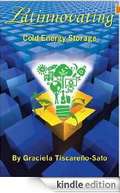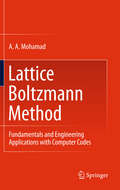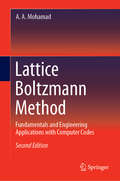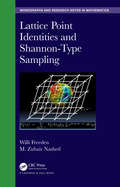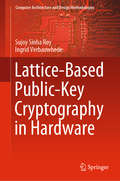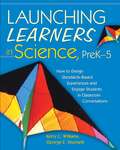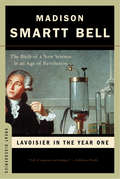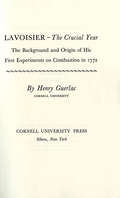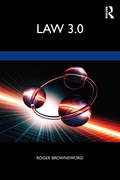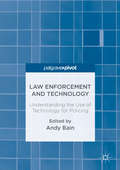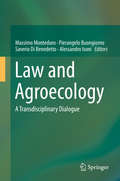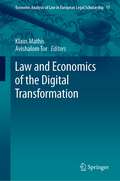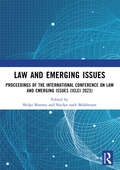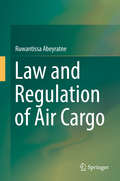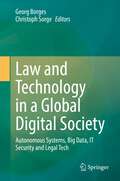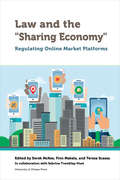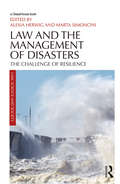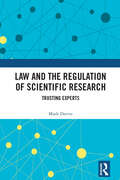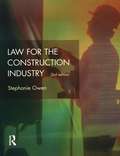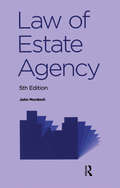- Table View
- List View
Latin-American Seeds: Agronomic, Processing and Health Aspects (Food Biotechnology and Engineering)
by Octavio Paredes-López María Reguera Norma Sammán Claudia M. HarosIn the last few years, the Latin-American seeds have gained increased importance (also due to the increased demand for gluten-free foods). Worldwide demand for Latin-American seeds and grains has risen in a high proportion. In parallel, seeds and grains' research from this region in all relevant fields has been intensified. Latin-American Seeds: Agronomic, Processing and Health Aspects summarizes the recent research on Latin-American crops regarding agronomic and botanical characteristics, composition, structure, use, production, technology, and impact on human health. Latin-American cultivars studied here are included in the groups of cereals, pseudo-cereals, oilseeds, and legumes that are used in a great variety of innovative and traditional foods. The main crops that are covered in this book are Latin-American maize (Zea mays), amaranth (Amaranthus spp), quinoa (Chenopodium spp), kañiwa (Chenopodium pallidicaule), chia (Salvia hispanica), sacha inchi (Plukenetia volubilis) and legumes such as black turtle and common beans (Phaseolus vulgaris) and tarwi (Lupinus mutabilis). Key Features: Contains updated information about recent research works on Latin-American crops Includes a variety of Latin-American plant species that are used in a great variety of innovative and traditional foods Addresses a wide range of topics related to agronomy, plant physiology, and nutritional and technological properties, processing, fractionation and development of new products for human health
Latinnovating: Green American Jobs and the Latinos Creating Them
by Graciela Tiscareño-SatoThis book profiles ten different career paths to becoming an environmental entrepreneur. This is the first book showcasing Latino-led innovation and entrepreneurship in the green economy. These ten case studies across ten sectors of our economy will inspire young people to follow these successful footsteps and emulate these highly educated, courageous Latino leaders as they create sustainable, industrial and social justice solutions to benefit all Americans.
Lattice Coding for Signals and Networks
by Ram ZamirUnifying information theory and digital communication through the language of lattice codes, this book provides a detailed overview for students, researchers and industry practitioners. It covers classical work by leading researchers in the field of lattice codes and complementary work on dithered quantization and infinite constellations, and then introduces the more recent results on 'algebraic binning' for side-information problems, and linear/lattice codes for networks. It shows how high dimensional lattice codes can close the gap to the optimal information theoretic solution, including the characterisation of error exponents. The solutions presented are based on lattice codes, and are therefore close to practical implementations, with many advanced setups and techniques, such as shaping, entropy-coding, side-information and multi-terminal systems. Moreover, some of the network setups shown demonstrate how lattice codes are potentially more efficient than traditional random-coding solutions, for instance when generalising the framework to Gaussian networks.
Lattice Boltzmann Method
by A. A. MohamadLattice Boltzmann Method introduces the lattice Boltzmann method (LBM) for solving transport phenomena - flow, heat and mass transfer - in a systematic way. Providing explanatory computer codes throughout the book, the author guides readers through many practical examples, such as: flow in isothermal and non-isothermal lid driven cavities;flow over obstacles;forced flow through a heated channel;conjugate forced convection; andnatural convection.Diffusion and advection-diffusion equations are discussed with applications and examples, and complete computer codes accompany the coverage of single and multi-relaxation-time methods. Although the codes are written in FORTRAN, they can be easily translated to other languages, such as C++. The codes can also be extended with little effort to multi-phase and multi-physics, if the reader knows the physics of the problem. Readers with some experience of advanced mathematics and physics will find Lattice Boltzmann Method a useful and easy-to-follow text. It has been written for those who are interested in learning and applying the LBM to engineering and industrial problems and it can also serve as a textbook for advanced undergraduate or graduate students who are studying computational transport phenomena.
Lattice Boltzmann Method: Fundamentals and Engineering Applications with Computer Codes
by A. A. MohamadThis book introduces readers to the lattice Boltzmann method (LBM) for solving transport phenomena – flow, heat and mass transfer – in a systematic way. Providing explanatory computer codes throughout the book, the author guides readers through many practical examples, such as:• flow in isothermal and non-isothermal lid-driven cavities;• flow over obstacles;• forced flow through a heated channel;• conjugate forced convection; and• natural convection.Diffusion and advection–diffusion equations are discussed, together with applications and examples, and complete computer codes accompany the sections on single and multi-relaxation-time methods. The codes are written in MatLab. However, the codes are written in a way that can be easily converted to other languages, such as FORTRANm Python, Julia, etc. The codes can also be extended with little effort to multi-phase and multi-physics, provided the physics of the respective problem are known.The second edition of this book adds new chapters, and includes new theory and applications. It discusses a wealth of practical examples, and explains LBM in connection with various engineering topics, especially the transport of mass, momentum, energy and molecular species.This book offers a useful and easy-to-follow guide for readers with some prior experience with advanced mathematics and physics, and will be of interest to all researchers and other readers who wish to learn how to apply LBM to engineering and industrial problems. It can also be used as a textbook for advanced undergraduate or graduate courses on computational transport phenomena
Lattice Point Identities and Shannon-Type Sampling (Chapman & Hall/CRC Monographs and Research Notes in Mathematics)
by Willi Freeden M. Zuhair NashedLattice Point Identities and Shannon-Type Sampling demonstrates that significant roots of many recent facets of Shannon's sampling theorem for multivariate signals rest on basic number-theoretic results. This book leads the reader through a research excursion, beginning from the Gaussian circle problem of the early nineteenth century, via the classical Hardy-Landau lattice point identity and the Hardy conjecture of the first half of the twentieth century, and the Shannon sampling theorem (its variants, generalizations and the fascinating stories about the cardinal series) of the second half of the twentieth century. The authors demonstrate how all these facets have resulted in new multivariate extensions of lattice point identities and Shannon-type sampling procedures of high practical applicability, thereby also providing a general reproducing kernel Hilbert space structure of an associated Paley-Wiener theory over (potato-like) bounded regions (cf. the cover illustration of the geoid), as well as the whole Euclidean space. All in all, the context of this book represents the fruits of cross-fertilization of various subjects, namely elliptic partial differential equations, Fourier inversion theory, constructive approximation involving Euler and Poisson summation formulas, inverse problems reflecting the multivariate antenna problem, and aspects of analytic and geometric number theory. Features: New convergence criteria for alternating series in multi-dimensional analysis Self-contained development of lattice point identities of analytic number theory Innovative lattice point approach to Shannon sampling theory Useful for students of multivariate constructive approximation, and indeed anyone interested in the applicability of signal processing to inverse problems.
Lattice-Based Public-Key Cryptography in Hardware (Computer Architecture and Design Methodologies)
by Ingrid Verbauwhede Sujoy Sinha RoyThis book describes the efficient implementation of public-key cryptography (PKC) to address the security challenges of massive amounts of information generated by the vast network of connected devices, ranging from tiny Radio Frequency Identification (RFID) tags to powerful desktop computers. It investigates implementation aspects of post quantum PKC and homomorphic encryption schemes whose security is based on the hardness of the ring-learning with error (LWE) problem. The work includes designing an FPGA-based accelerator to speed up computation on encrypted data in the cloud computer. It also proposes a more practical scheme that uses a special module called recryption box to assist homomorphic function evaluation, roughly 20 times faster than the implementation without this module.
Lattices of Dielectric Resonators
by Alexander TrubinThis book provides the analytical theory of complex systems composed of a large number of high-Q dielectric resonators. Spherical and cylindrical dielectric resonators with inferior and also whispering gallery oscillations allocated in various lattices are considered. A new approach to S-matrix parameter calculations based on perturbation theory of Maxwell equations, developed for a number of high-Q dielectric bodies, is introduced. All physical relationships are obtained in analytical form and are suitable for further computations. Essential attention is given to a new unified formalism of the description of scattering processes. The general scattering task for coupled eigen oscillations of the whole system of dielectric resonators is described. The equations for the expansion coefficients are explained in an applicable way. The temporal Green functions for the dielectric resonator are presented. The scattering process of short pulses in dielectric filter structures, dielectric antennas and lattices of dielectric resonators is discussed.
Launching Learners in Science, PreK5: How to Design Standards-Based Experiences and Engage Students in Classroom Conversations
by Kerry C. Williams George E. VeomettThe only way to teach science is to do science. The combination of teaching and doing involves three elements: knowing content, teachers knowing and understanding themselves as teachers and learners, and, most importantly, knowing children. Kerry C. Williams and George E. Veomett describe principles and requirements that reflect the National Science Education Standards for the active learning of science. They brilliantly identify key ingredients for primary students and outline the best course of action to aid their development as young scientists.Using research on cognitive and neural development and motivational theory from the work of Piaget and Vygotsky, this is an invaluable tool for teachers inexperienced in science. It will help you discover new ways to think about science and develop lessons that are rich, fun, and authentic for both you and your students.All educators will find examples, questions, stories, and thought-provoking ideas to give students a strong start in science achievement, plus: Six key elements to build into science instruction: observing, representing, organizing, patterning and questioning, experimenting, and sharing How-to's for incorporating inquiry, workshops, centers, and projects in primary and elementary classrooms A four-step system-choice, planning, doing, reviewing-that helps promote learning in science and across all subjects
Lavoisier in the Year One: The Birth of a New Science in an Age of Revolution (Great Discoveries)
by Madison Smartt Bell"Fresh . . . solid . . . full of suspense and intrigue."--Publishers Weekly Antoine Lavoisier reinvented chemistry, overthrowing the long-established principles of alchemy and inventing an entirely new terminology, one still in use by chemists. Madison Smartt Bell's enthralling narrative reads like a race to the finish line, as the very circumstances that enabled Lavoisier to secure his reputation as the father of modern chemistry--a considerable fortune and social connections with the likes of Benjamin Franklin--also caused his glory to be cut short by the French Revolution.
Lavoisier—the Crucial Year: The Background and Origin of His First Experiments on Combustion in 1772
by Henry GuerlacThe author explores the origins of the eighteenth-century chemical revolution as it centers on Antoine-Laurent Lavoisier's earliest work on combustion. He shows that the main lines of Lavoisier's theory—including his theory of a heat-fluid, caloric—were elaborated well before his discovery of the role played by oxygen. Contrary to the opinion prevailing at that time, Lavoisier suspected, and demonstrated by experiment, that common air, or some portion of it, combines with substances when they are burned.Professor Guerlac examines critically the theories of other historians of science concerning these first experiments, and tries to unravel the influences which French, German, and British chemists may have had on Lavoisier. He has made use of newly discovered material on this phase of Lavoisier's career, and includes an appendix in which the essential documents are printed together for the first time.
Law 3.0: Rules, Regulation, and Technology
by Roger BrownswordPutting technology front and centre in our thinking about law, this book introduces Law 3.0: the future of the legal landscape. Technology not only disrupts the traditional idea of what it is ‘to think like a lawyer,’ as per Law 1.0; it presents major challenges to regulators who are reasoning in a Law 2.0 mode. As this book demonstrates, the latest developments in technology offer regulators the possibility of employing a technical fix rather than just relying on rules – thus, we are introducing Law 3.0. Law 3.0 represents, so to speak, the state we are in and the conversation that we now need to have, and this book identifies some of the key points for discussion in that conversation. Thinking like a lawyer might continue to be associated with Law 1.0, but from 2020 onward, Law 3.0 is the conversation that we all need to join. And, as this book argues, law and the evolution of legal reasoning cannot be adequately understood unless we grasp the significance of technology in shaping both legal doctrine and our regulatory thinking. This is a book for those studying, or about to study, law – as well as others with interests in the legal, political, and social impact of technology.
Law Enforcement and Technology: Understanding The Use Of Technology For Policing
by Andy BainThis edited book explores the history, development and use of technology in the policing of society, showing that technology plays a key, if not pivotal role in the work of law enforcement. The authors analyse several examples of technology in common use today, which include both officers' equipment and technology used by crime scene investigation teams. They discuss the supportive role that technology plays in the investigation process as well as the concerns that may arise from a reliance upon technological advances. The book offers the reader a unique look at the scholarly and professional experience, with chapters written by academic researchers, as well as a number practitioners from the field of policing. It is essential reading for all those interested in a constantly changing and evolving field with implications for both theory and practice.
Law and Agroecology
by Massimo Monteduro Pierangelo Buongiorno Saverio Benedetto Alessandro IsoniThis book represents a first attempt to investigate the relations between Law and Agroecology. There is a need to adopt a transdisciplinary approach to multifunctional agriculture in order to integrate the agroecological paradigm in legal regulation. This does not require a super-law that hierarchically purports to incorporate and supplant the existing legal fields; rather, it calls for the creation of a trans-law that progressively works to coordinate interlegalities between different legal fields, respecting their autonomy but emphasizing their common historical roots in rus in the process. Rus, the rural phenomenon as a whole, reflects the plurality and interdependence of different complex systems based jointly on the land as a central point of reference. "Rural" is more than "agricultural": if agriculture is understood traditionally as an activity aimed at exploiting the land for the production of material goods for use, consumption and private exchange, rurality marks the reintegration of agriculture into a broader sphere, one that is not only economic, but also social and cultural; not only material, but also ideal, relational, historical, and symbolic; and not only private, but also public. In approaching rus, the natural and social sciences first became specialized, multiplied, and compartmentalized in a plurality of first-order disciplines; later, they began a process of integration into Agroecology as a second-order, multi-perspective and shared research platform. Today, Agroecology is a transdiscipline that integrates other fields of knowledge into the concept of agroecosystems viewed as socio-ecological systems. However, the law seems to still be stuck in the first stage. Following a reductionist approach, law has deconstructed and shattered the universe of rus into countless, disjointed legal elementary particles, multiplying the planes of analysis and, in particular, keeping Agricultural Law and Environmental Law two separate fields.
Law and Economics of the Digital Transformation (Economic Analysis of Law in European Legal Scholarship #15)
by Klaus Mathis Avishalom TorThis book pursues the questions from a broad range of law and economics perspectives. Digital transformation leads to economic and social change, bringing with it both opportunities and risks. This raises questions of the extent to which existent legal frameworks are still sufficient and whether there is a need for new or additional regulation in the affected areas: new demands are made on the law and jurisprudence.
Law and Emerging Issues: Proceedings of the International Conference on Law and Emerging Issues (ICLEI 2023)
In the ever-evolving landscape of law and governance, adaptation and innovation are key to addressing the challenges of our times. This edited volume is a testament to the ever-evolving nature of the legal field and the ongoing efforts of legal scholars and academicians to dissect, analyze, and grapple with the challenges and opportunities presented by these changes. The topics covered in this book span a wide spectrum of legal domains, reflecting the complex and rapidly changing nature of our contemporary world. From corporate governance structures to emerging challenges in the digital space, from analyzing the implications of the Social Security Code 2020 in India to understanding the legal developments surrounding unorganized migrant workers during the COVID-19 pandemic, the breadth of subjects addressed here is both impressive and vital.
Law and Justice in a Globalized World: Proceedings of the Asia-Pacific Research in Social Sciences and Humanities, Depok, Indonesia, November 7-9, 2016: Topics in Law and Justice
by Harkristuti Harkrisnowo Hikmahanto Juwana Yu Un OppusungguThe book consists of a selection of papers presented at the Asia-Pacific Research Conference on Social Sciences and Humanities. It contains essays on current legal issues in law and justice, and their role and transformation in a globalizing world. Topics covered include human rights, criminal law, good governance, democracy, foreign investment, and regional integration. The conference focused on Asia and the Pacific, two regions where law has taken an important position in creating and shaping the regional integrations, new legal institutions, and norms. This reconfirms the idea that the legal system is extremely important in the global world. This book provides new insights and new horizons on how law and justice took part in globalizing human interaction, especially in the Asia-Pacific region.
Law and Regulation of Air Cargo
by Ruwantissa AbeyratneThis book explores the legal and regulatory aspects of the complex air cargo sector, discussing in detail the general principles of the carriage of air cargo; artificial intelligence and air cargo; facilitation; carriage of hazardous goods; human remains; and animals, as well as cargo security; price fixing and anti competitive conduct in air cargo operations; liability issues; the air cargo supply chain and contract of carriage. It also discusses related achievements of the International Civil Aviation Organization; the International Air Transport Association and Airports Council International. The value of goods carried by airlines represents 7.4% of the global Gross Domestic Product. While cargo carried by air accounts for less than 1% of global cargo carriage, airlines carry 35% of the value of world trade, making this industry highly valuable and efficient, and the most reliable way to transport goods throughout the world. On average, airlines transport 52 million metric tons of goods per annum, worth an equivalent of $6.8 trillion, i.e. $18.6 billion worth of goods daily.
Law and Technology in a Global Digital Society: Autonomous Systems, Big Data, IT Security and Legal Tech
by Georg Borges Christoph SorgeThis book examines central aspects of the new technologies and the legal questions raised by them from both an international and an inter-disciplinary perspective. The technology revolution and the global networking of IT systems pose enormous challenges for the law. Current areas of discussion relate to autonomous systems, big data and issues surrounding legal tech. Ensuring data protection and IT security as well as the creation of a legal framework for the new technology as a whole can only be achieved through international and inter-disciplinary co-operation.The team of authors is made up of experienced, internationally renowned experts as well as young researchers and professionals who give valuable insights from numerous different jurisdictions. This book is written for jurists and those responsible for technology in public authorities and companies as well as practising lawyers and researchers.
Law and the "Sharing Economy": Regulating Online Market Platforms (Law, Technology and Media)
by Mariana Valverde Eric Tucker Michael Geist Harry Arthurs Francesco Ducci Marie-Cécile Escande-Varniol Vincent Gautrais Eran Kaplinsky Nofar Sheffi Sabrina Tremblay-HuetControversy shrouds sharing economy platforms. It stems partially from the platforms’ economic impact, which is felt most acutely in certain sectors: Uber drivers compete with taxi drivers; Airbnb hosts compete with hotels. Other consequences lie elsewhere: Uber is associated with a trend toward low-paying, precarious work, whereas Airbnb is accused of exacerbating real estate speculation and raising the cost of long-term rental housing. While governments in some jurisdictions have attempted to rein in the platforms, technology has enabled such companies to bypass conventional regulatory categories, generating accusations of “unfair competition” as well as debates about the merits of existing regulatory regimes. Indeed, the platforms blur a number of familiar distinctions, including personal versus commercial activity; infrastructure versus content; contractual autonomy versus hierarchical control. These ambiguities can stymie legal regimes that rely on these distinctions as organizing principles, including those relating to labour, competition, tax, insurance, information, the prohibition of discrimination, as well as specialized sectoral regulation. This book is organized around five themes: technologies of regulation; regulating technology; the sites of regulation (local to global); regulating markets; and regulating labour. Together, the chapters offer a rich variety of insights on the regulation of the sharing economy, both in terms of the traditional areas of law they bring to bear, and the theoretical perspectives that inform their analysis. Published in English.
Law and the Management of Disasters: The Challenge of Resilience (Law, Science and Society)
by Marta Simoncini Alexia HerwigDisasters raise serious challenges for contemporary legal orders: they demand significant management, but usually amidst massive disruption to the normal functioning of state authority and society. When dealing with disasters, law has traditionally focused on contingency planning and recovery. More recently, however, ‘resilience’ has emerged as a key concept in effective disaster management policies and strategies, aiming at minimising the impact of events, so that the normal functioning of society and the state can be preserved. This book analyses the contribution of law to resilience building by looking at law’s role in the different phases of the disaster regulatory process: risk assessment, risk management, emergency intervention, and recovery. More specifically, it addresses how law can effectively contribute to resilience-oriented distaster management policies, and what legal instruments can support effective resilience-building.
Law and the Regulation of Scientific Research: Trusting Experts
by Mark DaviesScientific research is fundamental to addressing issues of great importance to the development of human knowledge. Scientific research fuels advances in medicine, technology and other areas important to society and has to be credible, trustworthy and able to command confidence in the face of inevitable uncertainties. Scientific researchers must be trusted and respected when they engage with knowledge acquisition and dissemination and as ethical guardians in their education and training roles of future generations of researchers. The core values of scientific research transcend disciplinary and national boundaries and approaches to the organisation and oversight of research systems can impact significantly upon the ethics and conduct of researchers. This book draws upon legal expertise to critically analyse issues of regulation, conduct and ethics at the important interface between scientific research and regulatory and legal environments. In so doing it aims to contribute important additional perspectives to the existing literature. Case studies are engaged with to assist with the critical analysis of the current position and the consideration of future possibilities. The book will be of interest to academics in the fields of science, law and policy; science and law students and scientific researchers at more advanced stages of their careers. Research professionals in government and the private sector and legal practitioners with interests in the regulation of research should also find the work of interest.
Law and the Technologies of the Twenty-First Century
by Roger Brownsword Morag GoodwinLaw and the Technologies of the Twenty-First Century provides a contextual account of the way in which law functions in a broader regulatory environment across different jurisdictions. It identifies and clearly structures the four key challenges that technology poses to regulatory efforts, distinguishing between technology as a regulatory target and tool, and guiding the reader through an emerging field that is subject to rapid change. By extensive use of examples and extracts from the texts and materials that form and shape the scholarly and public debates over technology regulation, it presents complex material in a stimulating and engaging manner. Co-authored by a leading scholar in the field with a scholar new to the area, it combines comprehensive knowledge of the field with a fresh approach. This is essential reading for students of law and technology, risk regulation, policy studies, and science and technology studies.
Law for the Construction Industry (Chartered Institute of Building)
by Stephanie Owen J.R. LewisLaw for the Construction Industry provides a comprehensive introduction to the English legal system and basic contract law for those involved in the construction industry. It covers the level 2 module on legal studies of The CIOB's Education Framework and is officially sanctioned by The CIOB as the recognised book for that module. The book assumes no previous knowledge of English law.The second edition has been brought fully up-to-date with the latest legal changes. It explains basic contract law and gives the reader an understanding of employment and consumer law whilst placing law in the context of the construction industry throughout.Law for the Construction Industry is a core textbook for the CIOB level 2 module on legal studies, as well as BTEC HNC/D and degree courses in building and construction management.
Law of Estate Agency
by John MurdochSince its first publication in 1975, John Murdoch’s Law of Estate Agency has been the leading work on this important subject. This new fifth edition offers authoritative guidance on all recent legal developments, both legislative and in the courts, of concern to practising estate agents. Judicial decisions on such matters as commission claims and liability for misdescription are of great concern to practitioners, as is the increasing tendency of clients to defend an action for fees by claiming that the agent’s terms of business contravene consumer protection rules inspired by the EU. These developments, and many more, are given expert coverage.

